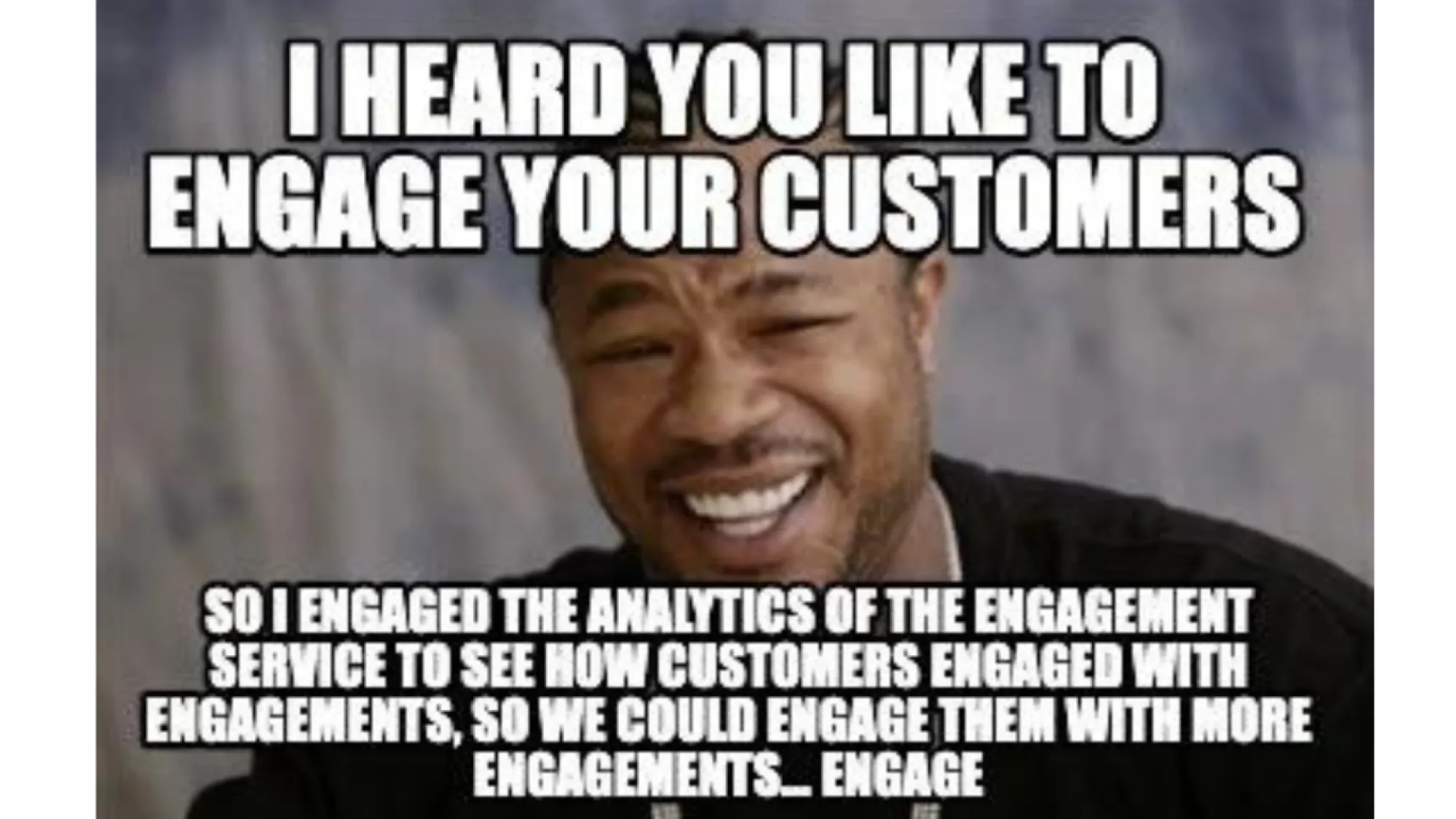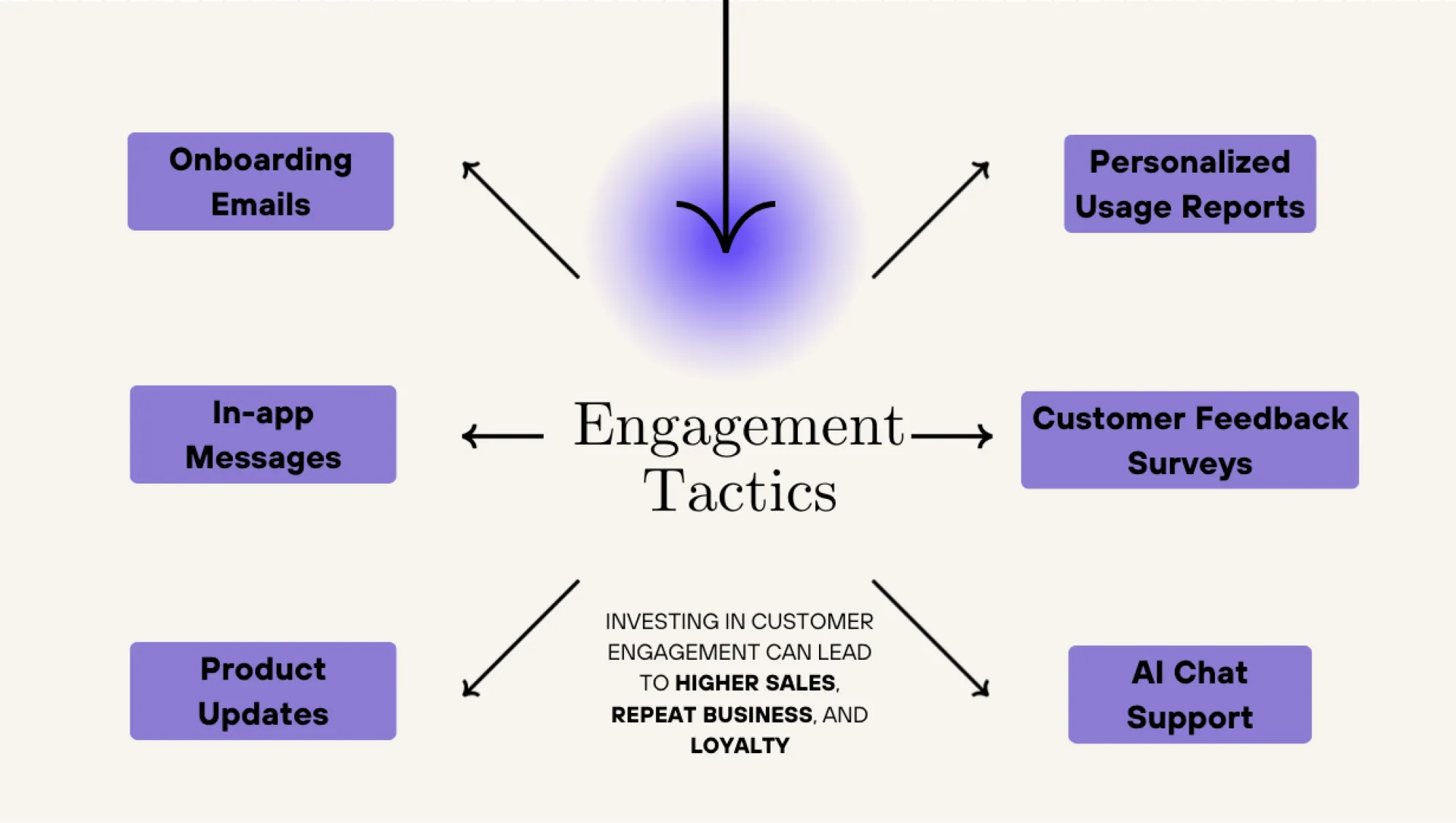Where you are now: Tired of free trial users vanishing faster than a viral meme. Struggling to keep users engaged longer than the lifespan of a session cookie. Dreaming of dollar signs but waking up to pennies.
Where you want to be: An alternative universe where prospects fall head over heels for your product, customers stick around longer than a never-ending Zoom meeting, and your revenue graph is on the up and up.
Maybe it’s time to develop a customer engagement model—a framework that SaaS companies use to better interact with customers, build relationships, and encourage loyalty.

Understanding customer engagement
Customer engagement is your friendly email newsletter, intuitive app interface, lightning-fast customer support, and every interaction that makes your customers think, "Wow, this SaaS product is FANTASTIC," or “This sucks.” It's the ongoing conversation between your company and its customers across multiple touchpoints.
Whether new purchases or renewed subscriptions, effective customer engagement fuels business growth. It's that simple. A data-driven customer engagement model is your playbook—a strategic framework that outlines how your SaaS company interacts with customers throughout their journey, from prospective clients to seasoned users.
A SaaS customer engagement model encompasses three things:
- Interactions: Touchpoints between customers and your brand.
- Experiences: The cumulative effects of these interactions shape how customers perceive and feel about your brand.
- Relationships: Ongoing connections that develop over time, built on trust, value, and mutual benefit.
Positive interactions cultivate positive experiences and foster positive customer relationships. A domino effect, if you will, that improves conversions, drives retention and loyalty, and increases customer lifetime value (CLV).
In the SaaS industry, acquiring new customers costs four to five times more than retaining existing ones. Customer retention is easier than acquisition, and loyal customers are more likely to embrace cross-selling and upselling opportunities.
But there’s a difference between SaaS and other industries
Think about the last time you bought a sofa or a pair of sneakers. Pretty straightforward, right? You see it, you like it, you buy it. Now, contrast that with production adoption. It’s completely different.
When your customers are looking at a SaaS product, they’re not just making a quick purchase - they’re potentially entering a long-term relationship. They might start with a demo, or free trial, and then chat with a sales rep to figure out if it's the right fit.
This winding road is a reflection of what makes SaaS unique. Customer’s don’t just buy a product; they invest in a solution that transforms how they work. And because of this, your SaaS company can't just focus on making the sale and calling it a day. You need to nurture customer relationships for the long haul.
If you’re building a SaaS customer engagement model, you need to tick this checklist:
✔️Data-driven personalization: Data is used to shape experiences that resonate. Every click, every feature, and every support ticket is an opportunity to better serve customers.
✔️Continuous evolution: Your product grows with your customers. You’re constantly iterating, pushing updates, and rolling out new features based on real users' needs and feedback.
✔️Community as a feature: User forums are a core product strategy. Fostering ecosystems where users become advocates and offer peer support is an extension of your own efforts.
✔️Long-term relationship focus: Your success metrics are tied to renewals and expansions.
✔️Proactive engagement: You don’t wait for issues to arise. You’re constantly reaching out, offering value, and ensuring users get maximum ROI.

How to create a customer engagement model
Great. Maybe you're nodding along and thinking, "Yeah, yeah, this all sounds peachy. But how do I actually turn this pie-in-the-sky theory into something real?"
1. Identify customer touchpoints
Start by identifying every potential customer interaction across all channels - both online and offline - including your website, social media, email, phone support, reddit forums, and even word-of-mouth. Consider both direct (e.g., customer service calls) and indirect (e.g., online reviews) touchpoints.
Remember that touchpoints occur before, during, and after purchase, and could look something like this table 👇
2. Map the customer journey
The typical customer journey goes like this: Awareness (that looks interesting), Consideration (hmm, maybe I need this), Evaluation (let's see how it stacks up), Purchase (sold), Onboarding (alright, how do I use this?), Usage (hey, this is pretty cool), Retention (I'm sticking with it), and finally, Advocacy (you guys have got to try this!).
HubSpot defines a customer journey map as "the touchpoints where you will meet your customers as they go through the stages of the buyer's journey." Creating one allows you to take control of every touchpoint at every stage of the journey instead of leaving it up to chance.
Examine each stage. What's going through your customer's mind? What are they feeling? What actions are they taking? Sprinkle in your identified touchpoints and watch how they all fit together. And remember, not all customers are created equal - so you'll need to create different journey maps for different customer personas.
3. Set engagement goals and KPIs
What does "engagement" mean for your SaaS business? Is it all about getting your users to click more buttons? Or maybe it's keeping them around longer? Perhaps it's just making sure they're grinning from ear to ear every time they use your product. Whatever it is, make sure it meshes with your big-picture business goals.
Once you've decided, you need to get specific. We're talking cold, hard numbers here - KPIs that you can actually measure. Maybe you're eyeing that sweet customer lifetime value, or you're all about that Net Promoter Score. It could be you're laser-focused on how often folks come back for more or how much time they're spending with your digital offerings.
Your KPIs should be ambitious but achievable. And have clear deadlines. Don't just set them and forget them. The business moves fast, and so do your customers. Keep your KPIs under review, tweaking and adjusting as needed.
Engagement strategies for SaaS businesses
There are two types of engagement strategies for SaaS companies. Proactive engagement addresses needs before they become issues. Obviously, this boosts satisfaction and retention because it shows you're on top of things—like sending a quick guide for an update before anyone asks. Then there's reactive engagement, which handles problems as they arise. Both strategies matter, but being proactive saves tons of admin trouble later.

For example, Command AI's AI CoPilot anticipates your users’ needs, offer timely guidance through product tours and onboarding checklists, for instance. It even automates some tasks, helping users navigate your software with ease.
We make it easy to proactively resolve potential stumbling blocks (user friction), which enhances the user experience and cultivates product loyalty. CoPilot is like having a knowledgeable assistant built right into your software, ensuring users get the most out of your product at all times.
How to measure and optimize SaaS customer engagement
The usual suspects, such as Google Analytics, Hotjar, Kissmetrics, and Salesforce, are excellent tools for monitoring and improving customer engagement metrics:
- Active Users (Daily/Monthly): How many users interact with your product or service regularly?
- Customer Lifetime Value (CLV): The total revenue your business can expect from a single customer account throughout the business relationship.
- Net Promoter Score (NPS): Gauge customer loyalty and likelihood to recommend your product or service.
- Retention Rate: The percentage of customers who continue using your product or service over time.
- Customer Satisfaction Score (CSAT): How satisfied customers are with your product, service, or specific interactions.
Pretend you're running TechFlow, a project management software company, and your retention rate is 70%. To improve this, you use CoPilot, enhancing onboarding and upgrading core features based on user feedback. Six months later, you're thrilled to see your retention rate climb to 80%. Simplified? Yes, but you get the idea.
Examples of successful SaaS engagement models
These case studies highlight the multifaceted nature of successful SaaS engagement models, from personalized onboarding to community building and AI-powered features.
Mailchimp
Mailchimp employs personalized onboarding emails, in-app tutorials, and targeted product recommendations based on user behavior. It uses AI-powered content suggestions to help users create effective campaigns. Regular feature announcements and success stories keep users informed and inspired. Mailchimp also leverages social media for community building and responsive customer support. Here is a list of Mailchimp alternatives.
Shopify
Shopify utilizes personalized dashboards and AI-powered insights to guide merchants' decision-making. They offer 24/7 support across multiple channels, including live chat and social media. Their "Shopify Compass" provides free courses and workshops. Plus, regular merchant meetups and the annual Shopify Unite conference foster community. Gamification in their partner program and showcase merchant success stories to inspire and retain users.
Slack
Slack employs contextual onboarding, suggesting relevant apps and integrations based on team size and industry. They use AI-powered features like Slack Connect to facilitate external communication. Regular product updates are announced through personalized in-app messages. They leverage user data to provide workspace insights and productivity tips. Community-driven Slack channels and localized events further boost engagement.

In short, customer engagement is ongoing
Engaged customers evolve into advocates, loyal supporters, and feedback sources. As you move forward, challenge yourself to view every interaction through the lens of engagement. How can you add value? How can you surprise and delight? Can you turn a simple transaction into a meaningful connection?
By prioritizing customer engagement, you're building a 5-star product, cultivating a community, fostering loyalty, and creating a foundation for long-term success. So, what's your next step in elevating your customer engagement? Will you revamp that neglected welcome email, or finally set up that user feedback loop you've been 'meaning to do'?"

















